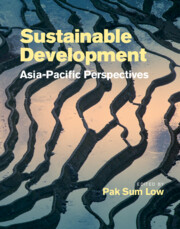Book contents
- Sustainable Development: Asia-Pacific Perspectives
- Sustainable Development: Asia-Pacific Perspectives
- Copyright page
- Dedication
- Contents
- Notes on contributors
- Peer reviewers
- Editor’s note
- Foreword
- Foreword
- Foreword
- Foreword
- Foreword
- Environmental keystones: Remembering Dr Mostafa Kamal Tolba
- Remembering Dr Mostafa Kamal Tolba
- Remembering Dr Mostafa Kamal Tolba
- Acronyms and abbreviations
- SI prefixes
- Unit abbreviations
- Chemical formulae
- Part I Sustainable Development: Theories and Practices
- Part II Sustainable Development: Challenges and Opportunities
- 17 Scientific responses in an era of global change
- 18 Government communication on transboundary haze: The nexus between public health and tourism
- 19 Biomass energy prospects: A promising fuel for sustainable development in Asia and the Pacific
- 20 Pathways to a more sustainable electricity sector in India
- 21 Gender equality and energy access: Barriers to maximizing development effectiveness in the SAARC region
- 22 The biosphere and the interactions between stratospheric ozone depletion and climate change
- 23 The political challenge of linking climate change and sustainable development policies: Risks and prospects
- 24 Social vulnerability to climate change in Cambodia, Lao PDR, and Vietnam
- 25 Sustainable development in Bangladesh: Bridging the SDGs and climate action
- 26 Sustainable development in Pakistan: Vulnerabilities and opportunities
- 27 Beyond protected areas: Biodiversity conservation and global change in Asia and the Pacific
- 28 Causes of land-use change and biodiversity loss in Monsoon Asia
- 29 Assessing linkages between land use and biodiversity: A case study from the Eastern Himalayas using low-cost, high-return survey technology
- 30 Where to invade next: Inaction on biological invasions threatens sustainability in a small island developing state of the tropical South Pacific
- 31 Did the Indian Ocean tsunami trigger a shift towards disaster risk reduction?
- 32 Cyclone Nargis and disaster risk management in Myanmar
- Index
- Endmatter
- References
24 - Social vulnerability to climate change in Cambodia, Lao PDR, and Vietnam
from Part II - Sustainable Development: Challenges and Opportunities
Published online by Cambridge University Press: 23 December 2021
- Sustainable Development: Asia-Pacific Perspectives
- Sustainable Development: Asia-Pacific Perspectives
- Copyright page
- Dedication
- Contents
- Notes on contributors
- Peer reviewers
- Editor’s note
- Foreword
- Foreword
- Foreword
- Foreword
- Foreword
- Environmental keystones: Remembering Dr Mostafa Kamal Tolba
- Remembering Dr Mostafa Kamal Tolba
- Remembering Dr Mostafa Kamal Tolba
- Acronyms and abbreviations
- SI prefixes
- Unit abbreviations
- Chemical formulae
- Part I Sustainable Development: Theories and Practices
- Part II Sustainable Development: Challenges and Opportunities
- 17 Scientific responses in an era of global change
- 18 Government communication on transboundary haze: The nexus between public health and tourism
- 19 Biomass energy prospects: A promising fuel for sustainable development in Asia and the Pacific
- 20 Pathways to a more sustainable electricity sector in India
- 21 Gender equality and energy access: Barriers to maximizing development effectiveness in the SAARC region
- 22 The biosphere and the interactions between stratospheric ozone depletion and climate change
- 23 The political challenge of linking climate change and sustainable development policies: Risks and prospects
- 24 Social vulnerability to climate change in Cambodia, Lao PDR, and Vietnam
- 25 Sustainable development in Bangladesh: Bridging the SDGs and climate action
- 26 Sustainable development in Pakistan: Vulnerabilities and opportunities
- 27 Beyond protected areas: Biodiversity conservation and global change in Asia and the Pacific
- 28 Causes of land-use change and biodiversity loss in Monsoon Asia
- 29 Assessing linkages between land use and biodiversity: A case study from the Eastern Himalayas using low-cost, high-return survey technology
- 30 Where to invade next: Inaction on biological invasions threatens sustainability in a small island developing state of the tropical South Pacific
- 31 Did the Indian Ocean tsunami trigger a shift towards disaster risk reduction?
- 32 Cyclone Nargis and disaster risk management in Myanmar
- Index
- Endmatter
- References
Summary
Reducing vulnerability to environmental change must be a key component of any strategy for sustainable development. We consider the situation of the nations of the Lower Mekong, namely Cambodia, Lao PDR, and Vietnam, focusing on the threat of climate change. We distinguish between physical vulnerability, characterized in terms of spatial exposure to hazardous events, and social vulnerability, which is a function of the social conditions and historical circumstances that put people at risk. As vulnerability is a dynamic condition, we frame the assessment in terms of the processes and trends that are shaping current patterns of vulnerability and resilience. The nations of the Lower Mekong face a range of potential trends in climate, with changes in the incidence of flooding, variability in water availability, the occurrence of drought and heat stress, the frequency and/or intensity of tropical cyclones, and, in coastal areas, sea-level rise posing the major risks. A baseline assessment of the social, economic, and political trends that are influencing present-day levels of social vulnerability highlights the fact that poverty is the largest barrier to developing the capacity to cope and adapt effectively with change. The situation of the poorest members of society is being adversely affected by trends in inequality, disparities in property rights, dismantling of agricultural cooperatives, unions, and various forms of financial support and changes in social structure and institutions. We identify an important tension that can exist between efforts aimed at improving the general economic situation and what is needed to improve resilience to climate stress, particularly among the rural poor. As far as adaptation is concerned, there are lessons for other regions in the traditional approaches developed within the Lower Mekong, as these nations have a rich history of managing their dynamic natural environment.
Keywords
- Type
- Chapter
- Information
- Sustainable Development: Asia-Pacific Perspectives , pp. 315 - 326Publisher: Cambridge University PressPrint publication year: 2022



